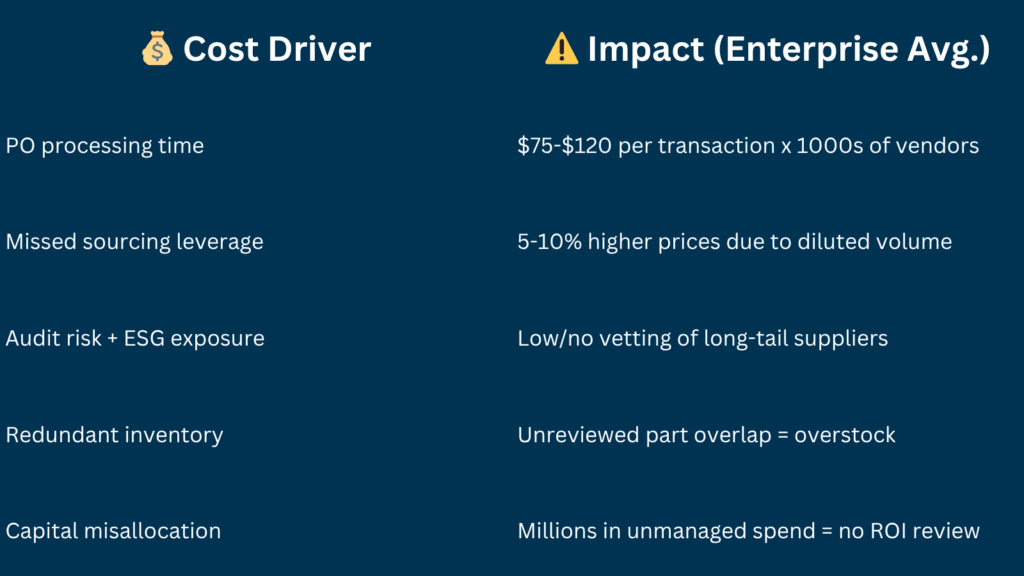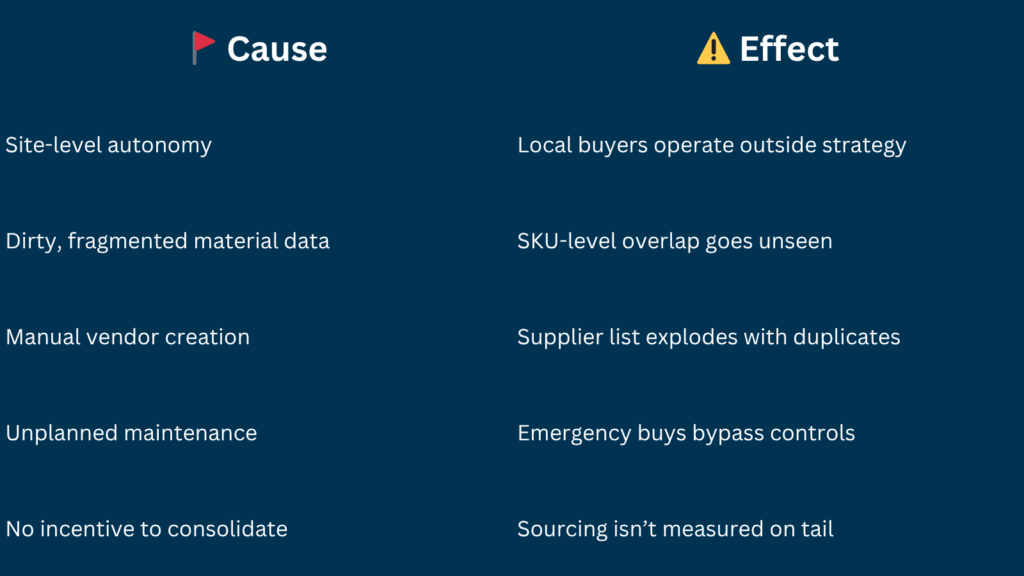Tail Spend Management for MRO: How to Cut Costs and Control Supplier Risk
The Spend No One Owns – But Everyone Pays For


It’s not on your strategic supplier list.
It’s not in your quarterly sourcing dashboard.
And it’s not showing up in savings reports.
But it’s bleeding your P&L.
Random one-off purchases. Unapproved vendors. Unmanaged SKUs.
Scattered across plants. Buried in ERP noise. Made outside of contracts.
This is tail spend in MRO – and left unchecked, it’s quietly draining millions from even the most “optimized” procurement orgs.
In This Guide, You’ll Learn:
- What tail spend looks like in MRO (and why it’s so slippery)
- Why it’s resistant to traditional procurement controls
- How AI makes it visible – and controllable – in weeks
- How to turn tail spend into a managed, cost-saving program
What Is Tail Spend in MRO?
Tail spend refers to low-volume, low-visibility purchases that fall outside formal procurement strategies – often unmanaged, uncategorized, and unreviewed.
In MRO, this means:
- Emergency part orders made by technicians
- Redundant purchases from unapproved vendors
- Decentralized buying from plants or maintenance teams
- Spot buys that bypass sourcing teams entirely
These decentralized purchases are often unmanaged and invisible to traditional procurement workflows.
These aren’t small purchases. They’re fragmented.
And in aggregate, they often make up 20-30% of total MRO spend – and 60-80% of the vendor base.
Tail spend analysis helps identify these transactions across systems to expose hidden cost and risk.
What Tail Spend Costs You – Financial Impact and Hidden P&L Waste
Tail spend creates a compound drain on performance:


Even a “low-risk” $600 item can trigger:
- Weeks of reconciling spend
- Stocking redundancy
- Disruption in vendor compliance metrics
This isn’t about pennies.
It’s about performance leakage that procurement can’t track – and finance can’t explain.
Why Tail Spend Management Fails – Even in Mature Teams
Tail spend doesn’t exist because no one cares.
It exists because no one owns it – and systems weren’t built to manage it.


Why It Stays Hidden – and How to Expose It
Internal friction keeps tail spend buried. Even smart teams face:
- Pushback from plants protecting “preferred” vendors
- Lack of time/resources to review low-dollar orders
- No system to flag redundancy or group similar items
- Sourcing’s focus on strategic categories (rightfully so)
Without a tail spend management system, teams have no way to flag redundant suppliers or rogue spend.
Tail spend isn’t solved with policy. It’s solved with visibility, unification, and contextual insight.
Tail Spend Optimization: How AI Improves Visibility and Control


Traditional spend cubes or ERP dashboards don’t solve tail spend. They show you what already happened – not what’s overlapping, redundant, or out of control.
Tail spend automation enables proactive detection and supplier control, instead of backward-looking reporting.
Verusen’s AI platform delivers:
1. Material + Supplier Data Unification
Connects material records and vendor data across sites – no manual mapping required.
2. Redundancy Detection
Groups vendors by part type, SKU classification, and price logic. Flags overlap and substitution risk.
3. Confidence-Based Categorization
AI classifies transactions as strategic, tactical, or tail – giving you a tail scorecard for the first time.
4. Prescriptive Consolidation Guidance
- Parts to standardize
- Vendors to sunset
- Contracts to expand for volume leverage
All without changing your ERP or disrupting local plant autonomy.
$800K Recovered in Tail Spend Waste
Company: Global Food & Beverage Manufacturer
Challenge:
- Unmanaged tail spend and price variance
- No visibility across sites
- Inability to consolidate suppliers or inventory
Solution:
- Applied AI to normalize data across systems
- Identified contract non-compliance and PPV gaps
- Consolidated suppliers and optimized stocking policies
Results:
- $800K+ in tail spend reduction
- Vendor base streamlined
- Strategic sourcing compliance improved
This tail spend software approach allowed sourcing teams to identify risk patterns and vendor overlap rapidly.
Tail Spend Management Solutions: What Strategic Execution Looks Like
- Real-time visibility into MRO vendor concentration
- Confidence-tagged parts and POs for easy review
- Mapped substitutions and sourcing overlap
- Automatic recommendations for consolidation
- Sourcing, finance, and ops aligned around one source of truth
- Integrated tail spend management solutions across plants and systems


FAQs
How fast can we identify tail spend?
Initial tail mapping typically happens in 2-4 weeks.
Does this require data cleansing or taxonomy work?
No – Verusen applies machine learning to normalize at ingestion.
Will this force all sites into central control?
No. It enables shared visibility and playbooks – not central command-and-control.
Ready to See What Tail Spend Is Really Costing You?
We’ll run a diagnostic using your own ERP or procurement exports – and show where tail spend is hiding, overlapping, and bleeding your margin.
→ Book a Tail Spend Diagnostic (Free)
